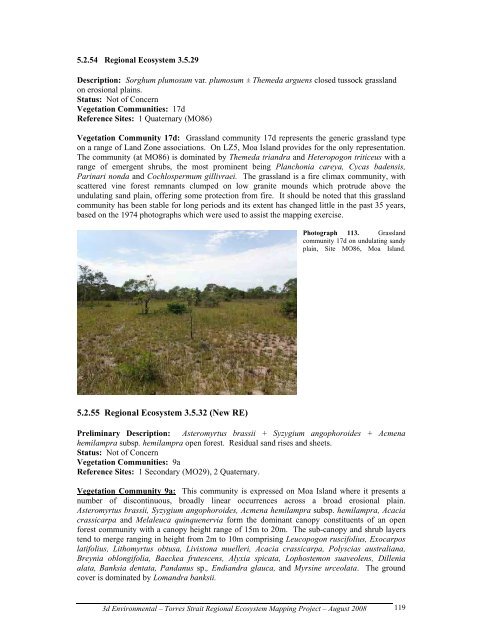Appendix 2 - Vegetation Communities and Regional Ecosystems
Appendix 2 - Vegetation Communities and Regional Ecosystems
Appendix 2 - Vegetation Communities and Regional Ecosystems
You also want an ePaper? Increase the reach of your titles
YUMPU automatically turns print PDFs into web optimized ePapers that Google loves.
5.2.54 <strong>Regional</strong> Ecosystem 3.5.29<br />
Description: Sorghum plumosum var. plumosum ± Themeda arguens closed tussock grassl<strong>and</strong><br />
on erosional plains.<br />
Status: Not of Concern<br />
<strong>Vegetation</strong> <strong>Communities</strong>: 17d<br />
Reference Sites: 1 Quaternary (MO86)<br />
<strong>Vegetation</strong> Community 17d: Grassl<strong>and</strong> community 17d represents the generic grassl<strong>and</strong> type<br />
on a range of L<strong>and</strong> Zone associations. On LZ5, Moa Isl<strong>and</strong> provides for the only representation.<br />
The community (at MO86) is dominated by Themeda tri<strong>and</strong>ra <strong>and</strong> Heteropogon triticeus with a<br />
range of emergent shrubs, the most prominent being Planchonia careya, Cycas badensis,<br />
Parinari nonda <strong>and</strong> Cochlospermum gillivraei. The grassl<strong>and</strong> is a fire climax community, with<br />
scattered vine forest remnants clumped on low granite mounds which protrude above the<br />
undulating s<strong>and</strong> plain, offering some protection from fire. It should be noted that this grassl<strong>and</strong><br />
community has been stable for long periods <strong>and</strong> its extent has changed little in the past 35 years,<br />
based on the 1974 photographs which were used to assist the mapping exercise.<br />
5.2.55 <strong>Regional</strong> Ecosystem 3.5.32 (New RE)<br />
Photograph 113. Grassl<strong>and</strong><br />
community 17d on undulating s<strong>and</strong>y<br />
plain, Site MO86, Moa Isl<strong>and</strong>.<br />
Preliminary Description: Asteromyrtus brassii + Syzygium angophoroides + Acmena<br />
hemilampra subsp. hemilampra open forest. Residual s<strong>and</strong> rises <strong>and</strong> sheets.<br />
Status: Not of Concern<br />
<strong>Vegetation</strong> <strong>Communities</strong>: 9a<br />
Reference Sites: 1 Secondary (MO29), 2 Quaternary.<br />
<strong>Vegetation</strong> Community 9a: This community is expressed on Moa Isl<strong>and</strong> where it presents a<br />
number of discontinuous, broadly linear occurrences across a broad erosional plain.<br />
Asteromyrtus brassii, Syzygium angophoroides, Acmena hemilampra subsp. hemilampra, Acacia<br />
crassicarpa <strong>and</strong> Melaleuca quinquenervia form the dominant canopy constituents of an open<br />
forest community with a canopy height range of 15m to 20m. The sub-canopy <strong>and</strong> shrub layers<br />
tend to merge ranging in height from 2m to 10m comprising Leucopogon ruscifolius, Exocarpos<br />
latifolius, Lithomyrtus obtusa, Livistona muelleri, Acacia crassicarpa, Polyscias australiana,<br />
Breynia oblongifolia, Baeckea frutescens, Alyxia spicata, Lophostemon suaveolens, Dillenia<br />
alata, Banksia dentata, P<strong>and</strong>anus sp., Endi<strong>and</strong>ra glauca, <strong>and</strong> Myrsine urceolata. The ground<br />
cover is dominated by Lom<strong>and</strong>ra banksii.<br />
3d Environmental – Torres Strait <strong>Regional</strong> Ecosystem Mapping Project – August 2008<br />
119


